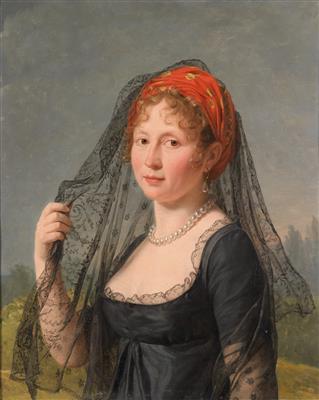Attributed to François-Pascal Simon, Baron Gérard

(Rome 1770–1837 Paris)
Portrait of a lady dressed in black,
oil on canvas, 71.5 x 57.8 cm, framed
Gérard arrived at the Pension du Roi in Paris at the age of twelve. After his apprenticeship under the sculptor Augustin Pajou and the history painter Nicolas-Guy Brenet, the artist entered the studio of Jacques-Louis David. In 1789 he competed for the Prix de Rome, which, however, was awarded to Girodet, his fellow student. After an absence he returned to Paris in 1791, but was unable to continue his education because of a lack of funds. In 1793, Gérard became a member of the Revolution’s tribunal through David’s intervention. In 1794, Gérard won the first prize for his painting 10 August 1792 (Besiege of the Palais des Tuileries). In 1795 he painted Belisarius, his first large history painting, for Jean-Baptiste Isabey (now in the Louvre, Paris). In 1799 he executed his famous portrait of Letizia Bonaparte (Madame Mère). In the years to come, Gérard became the most popular portraitist during the Empire and Restoration. In 1810 he exhibited as many as fourteen portraits at the Paris Salon. Gérard painted most of the celebrities of his period and conducted a fashionable salon in Paris. He was also a successful history painter. In 1810 he painted the Battle of Austerlitz and in 1817 completed the Entrance of Henry IV in Paris for King Louis XVII. In later years he was somewhat less sought-after, due to the rise of Romanticism. Having been raised to the rank of baron in 1809, Gérard died in 1837, a member of the Institut de France an officer of the Legion of Honour, and court painter to King Louis Philippe.
Despite the undoubtable high quality of the execution, it has hitherto not been possible to identify the artist of the present painting conclusively. Although it is stylistically very similar to the portraits of Gérard, it could also originate from one of the painters from the closer circle of Jacques Louis David, if not even from David himself. Different parties have pointed out the connection to Marie Denise Villers’ Une étude de femme d’après nature (also called Portrait de Madame Soustras), which likewise depicts an elegant lady with a black veil. Although the current portrait certainly does not originate from Villers herself, some scholars assume that the artist must have known the portrait Madame Soustras. It is possible they originated from the same workshop. Like Gérard, Villers also worked in David’s studio.
Expert: Dr. Alexander Strasoldo
 Dr. Alexander Strasoldo
Dr. Alexander Strasoldo
+43 1 515 60 403
oldmasters@dorotheum.com
09.04.2014 - 18:00
- Dosažená cena: **
-
EUR 24.700,-
- Odhadní cena:
-
EUR 20.000,- do EUR 30.000,-
Attributed to François-Pascal Simon, Baron Gérard
(Rome 1770–1837 Paris)
Portrait of a lady dressed in black,
oil on canvas, 71.5 x 57.8 cm, framed
Gérard arrived at the Pension du Roi in Paris at the age of twelve. After his apprenticeship under the sculptor Augustin Pajou and the history painter Nicolas-Guy Brenet, the artist entered the studio of Jacques-Louis David. In 1789 he competed for the Prix de Rome, which, however, was awarded to Girodet, his fellow student. After an absence he returned to Paris in 1791, but was unable to continue his education because of a lack of funds. In 1793, Gérard became a member of the Revolution’s tribunal through David’s intervention. In 1794, Gérard won the first prize for his painting 10 August 1792 (Besiege of the Palais des Tuileries). In 1795 he painted Belisarius, his first large history painting, for Jean-Baptiste Isabey (now in the Louvre, Paris). In 1799 he executed his famous portrait of Letizia Bonaparte (Madame Mère). In the years to come, Gérard became the most popular portraitist during the Empire and Restoration. In 1810 he exhibited as many as fourteen portraits at the Paris Salon. Gérard painted most of the celebrities of his period and conducted a fashionable salon in Paris. He was also a successful history painter. In 1810 he painted the Battle of Austerlitz and in 1817 completed the Entrance of Henry IV in Paris for King Louis XVII. In later years he was somewhat less sought-after, due to the rise of Romanticism. Having been raised to the rank of baron in 1809, Gérard died in 1837, a member of the Institut de France an officer of the Legion of Honour, and court painter to King Louis Philippe.
Despite the undoubtable high quality of the execution, it has hitherto not been possible to identify the artist of the present painting conclusively. Although it is stylistically very similar to the portraits of Gérard, it could also originate from one of the painters from the closer circle of Jacques Louis David, if not even from David himself. Different parties have pointed out the connection to Marie Denise Villers’ Une étude de femme d’après nature (also called Portrait de Madame Soustras), which likewise depicts an elegant lady with a black veil. Although the current portrait certainly does not originate from Villers herself, some scholars assume that the artist must have known the portrait Madame Soustras. It is possible they originated from the same workshop. Like Gérard, Villers also worked in David’s studio.
Expert: Dr. Alexander Strasoldo
 Dr. Alexander Strasoldo
Dr. Alexander Strasoldo
+43 1 515 60 403
oldmasters@dorotheum.com
|
Horká linka kupujících
Po-Pá: 10.00 - 17.00
old.masters@dorotheum.at +43 1 515 60 403 |
| Aukce: | Obrazy starých mistr? |
| Typ aukce: | Salónní aukce |
| Datum: | 09.04.2014 - 18:00 |
| Místo konání aukce: | Wien | Palais Dorotheum |
| Prohlídka: | 29.03. - 09.04.2014 |
** Kupní cena vč. poplatku kupujícího a DPH
Není již možné podávat příkazy ke koupi přes internet. Aukce se právě připravuje resp. byla již uskutečněna.
Všechny objekty umělce
